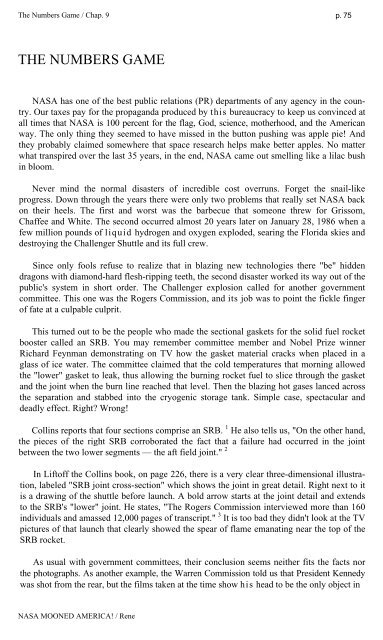Rene-NASA-Mooned-America
Rene-NASA-Mooned-America
Rene-NASA-Mooned-America
You also want an ePaper? Increase the reach of your titles
YUMPU automatically turns print PDFs into web optimized ePapers that Google loves.
The Numbers Game / Chap. 9 p. 75<br />
THE NUMBERS GAME<br />
<strong>NASA</strong> has one of the best public relations (PR) departments of any agency in the country.<br />
Our taxes pay for the propaganda produced by this bureaucracy to keep us convinced at<br />
all times that <strong>NASA</strong> is 100 percent for the flag, God, science, motherhood, and the <strong>America</strong>n<br />
way. The only thing they seemed to have missed in the button pushing was apple pie! And<br />
they probably claimed somewhere that space research helps make better apples. No matter<br />
what transpired over the last 35 years, in the end, <strong>NASA</strong> came out smelling like a lilac bush<br />
in bloom.<br />
Never mind the normal disasters of incredible cost overruns. Forget the snail-like<br />
progress. Down through the years there were only two problems that really set <strong>NASA</strong> back<br />
on their heels. The first and worst was the barbecue that someone threw for Grissom,<br />
Chaffee and White. The second occurred almost 20 years later on January 28, 1986 when a<br />
few million pounds of liquid hydrogen and oxygen exploded, searing the Florida skies and<br />
destroying the Challenger Shuttle and its full crew.<br />
Since only fools refuse to realize that in blazing new technologies there "be" hidden<br />
dragons with diamond-hard flesh-ripping teeth, the second disaster worked its way out of the<br />
public's system in short order. The Challenger explosion called for another government<br />
committee. This one was the Rogers Commission, and its job was to point the fickle finger<br />
of fate at a culpable culprit.<br />
This turned out to be the people who made the sectional gaskets for the solid fuel rocket<br />
booster called an SRB. You may remember committee member and Nobel Prize winner<br />
Richard Feynman demonstrating on TV how the gasket material cracks when placed in a<br />
glass of ice water. The committee claimed that the cold temperatures that morning allowed<br />
the "lower" gasket to leak, thus allowing the burning rocket fuel to slice through the gasket<br />
and the joint when the burn line reached that level. Then the blazing hot gases lanced across<br />
the separation and stabbed into the cryogenic storage tank. Simple case, spectacular and<br />
deadly effect. Right Wrong!<br />
Collins reports that four sections comprise an SRB. 1 He also tells us, "On the other hand,<br />
the pieces of the right SRB corroborated the fact that a failure had occurred in the joint<br />
between the two lower segments — the aft field joint." 2<br />
In Liftoff the Collins book, on page 226, there is a very clear three-dimensional illustration,<br />
labeled "SRB joint cross-section" which shows the joint in great detail. Right next to it<br />
is a drawing of the shuttle before launch. A bold arrow starts at the joint detail and extends<br />
to the SRB's "lower" joint. He states, "The Rogers Commission interviewed more than 160<br />
individuals and amassed 12,000 pages of transcript." 3 It is too bad they didn't look at the TV<br />
pictures of that launch that clearly showed the spear of flame emanating near the top of the<br />
SRB rocket.<br />
As usual with government committees, their conclusion seems neither fits the facts nor<br />
the photographs. As another example, the Warren Commission told us that President Kennedy<br />
was shot from the rear, but the films taken at the time show his head to be the only object in<br />
<strong>NASA</strong> MOONED AMERICA! / <strong>Rene</strong>


